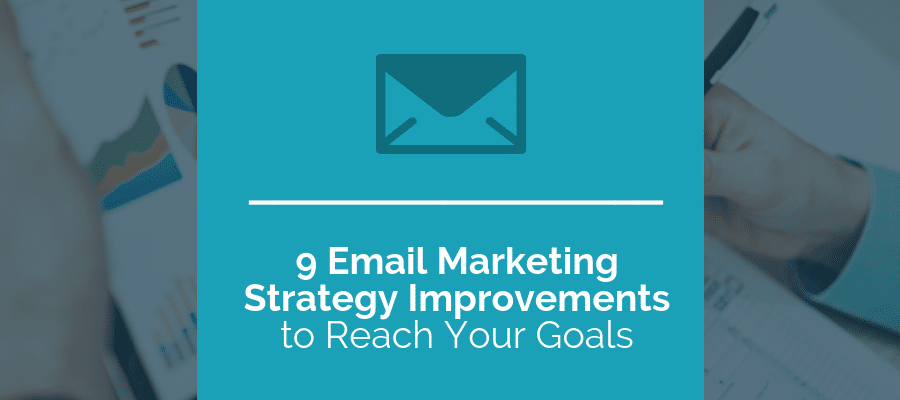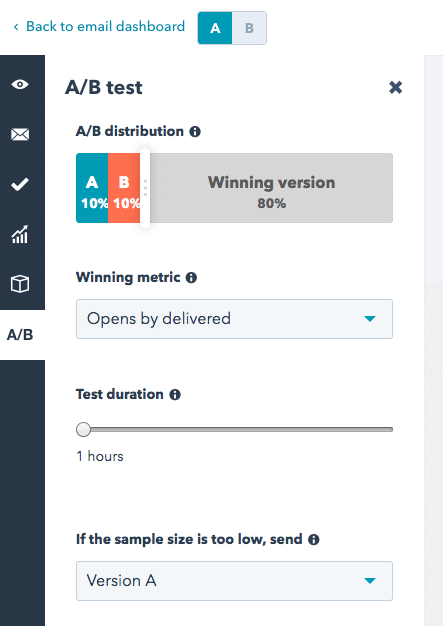
Email marketing can produce enormous ROI, with some companies earning back as much as $44 for every $1 spent. The right email marketing strategy can make the difference between inbox clutter and impactful messaging. Whether you’re working to improve your strategy, you’re starting focused email marketing for the first time, or you’re not sure how to meet your goals, these email marketing strategy tips can help.
9 Email Marketing Strategy Improvements to Reach Your Goals
1. Set Goals to Stay on Track
First and foremost, it’s important to set goals for your email marketing strategy, no matter what stage you’re in. What do you want to improve and why? Set goals that are obtainable, but challenging. Also, you should have KPIs for measuring your progress. These might be improved open rates, clicks, a larger email list, more leads, or something else.
It’s a good idea to break a larger, long-term goal into smaller pieces. For example, if your ultimate goal is to increase purchases, there are several ways you could go about this. You might want to work on reaching more potential customers and improving your email list. Or, you might focus on getting more opens from your existing list, or increasing clicks from your existing engaged contacts.
2. Personalize to Get Customers’ Attention
Using a person’s name in conversation creates closeness, empathy, and attention between you. This principle also extends to a well-known email marketing strategy. Inserting simple personalization tokens, such as first name, is a good way to seize your contact’s attention. You can use more in-depth information where possible to customize the content further and inspire more interest. For example, you might personalize content for a contact’s position, a problem they’re trying to solve.
Personalization and segmenting, which we’ll discuss later, are closely related. The questions that you ask and the strategies that you use to segment your content will likely play a role in how you personalize it as well.
3. Find the Best Content With an A/B Test

You can find Hubspot’s A/B test at the bottom of your sidebar as you construct an email.
When you open an email, you might not be seeing the same version as everyone else. You may be a part of an A/B test, which pits two similar versions of the same email against one another, to see which gets more opens or engagement. This is an email marketing strategy that can help you hone in on the content, subject lines, even the design or color scheme that works the best.
It’s best to test small changes one at a time, so you know which change sparked the increased engagement or opens. You can conduct an A/B test on an email that you deliver to your entire list, or you might conduct A/B tests only for certain segments. For example, you may want to know if a 30% discount or free shipping generates more engagement from previous customers, but you don’t want to offer this to your recently converted leads. Construct an email only for previous customers and conduct an A/B test to experiment with this segment only.
4. Use an Attention-Grabbing Subject Line
We shouldn’t judge a book by its cover, but most of us do, and your email subject line is like the cover of your email. Your customers will read your subject line and decide from there if it’s worth their time, or goes in the trash folder straightaway.
A few subject lines are particularly attention-grabbing, but you should be careful to use these sparingly. Former President Barack Obama famously reached out to campaign followers with simple, but striking subject lines like “wow” or “hey.” Many non-profit organizations work to strike a similar familiarity chord with subject lines like “thank you” or “your gift.” While these can generate more clicks, save these for important messages, or the strategy can seem like a gimmick. Using a contact’s first name in the subject line tends to increase clicks as well, but, again, be careful not to overuse this tactic. Keep in mind that nearly half of all email opens occur on mobile devices, according to Buffer. This limits the visible characters to about 35, so short and sweet is often a safe route.
Here are a few other subject line ideas you can test to see what works with your audience. Notice that these are somewhat casual, which might not be suitable for the tone or voice of your business.
- Questions: Wondering about great shopping deals?
- Familiar: Just checking in
- Quick: Thank you
- Casual: Hey [First name], got a sec?
- Personal: We’ve got deals just for you
- Appreciation: Your support keeps us going
- Ambiguous: OK [First name], here’s the plan.
- Trigger: Heard you like [shopping item]
- Event: You’re invited
- Holiday: You’re covered for [holiday]
5. Segment Leads to Find the Right Content
Different people want different things. If you can find out what your contacts are looking for, you can deliver an email marketing strategy that really gets through. Segmenting can help you do this.
Segmenting means dividing your email list up into different groups, but how you segment these groups will play a major role in determining your email content. Before you segment, consider what you want the shared traits in the segment to tell you. You might, for example, segment based on demographic data, like income, gender, or age, but would this really help you emails to be more effective? If you sell clothing, it might, but if you sell car repair services, probably not.
Consider the following ways you might segment your emails, and what these segmentation strategies might help you do.
- Demographics: Knowing age, gender, income, location or other information can help you show your contact the most relevant products, stores, discounts, or deals.
- Interests: Why did your contact enroll in your email list to begin with? What are they looking for? This can help you show them the most relevant content.
- Problem: Knowing your customer’s pain point will put you on the fastest route towards solving it. Show them instructional content, helpful products, or how-to guides that will solve these issues.
- Purchasing style: Is your contact an impulse buyer, holiday shopper, budgeter, or big spender? Knowing how they like to buy will help you craft emails that suit their preferred experience.
- Content type: Does your customer prefer video, short-form text, long-form text, infographics, or something else? Showing the right people the right content can help to improve engagement.
- Sales funnel: If your customer just converted, they’re probably not yet ready for a sales pitch. But if they’re browsing your store or product brochures, they’re ready to buy. Segment your leads by sales funnel stage to show the right content.
6. Trigger Emails for Fast Response
Some actions require special attention, but you don’t have time to message a thousand leads individually. Triggered emails can help you do this without taking up extra time. These are automated emails that automatically send when a contact completes—or doesn’t complete—a particular action. With these emails, you can send specific content that addresses the lead’s action or inaction.
Here are a few common and effective triggered emails.
- Abandoned cart: Something stopped your customer from completing their order. Design an email that will show them their abandoned cart, and answer common questions or resolve complaints they might have had.
- Inactivity: Your customer hasn’t signed in in a while. Check in with them and tell them about special features or new products, or what they might be missing.
- Completed download: This may be how you got your lead in the first place, but if they download other documents, you can show more targeted content.
- Help desk: If your customer asked a question to your service department or chatbot, ask if their issue was resolved and give them more information where possible.
- Regular visitor: If the lead often looks at your blog, they might be influenced by other informational content if you offer it to them directly. If the lead often scans your store, but doesn’t buy, a discount might sway their decision.
7. Use a Real Name for More Authenticity
Spam emails comes from spam addresses, and most people can recognize these readily. Instead of using a catch-all email like info@yourbusinessname, use a real person’s email, name and, if possible, picture or phone number. If your email appears to come from a real person—or at least has a real person’s name attached to it—your leads will consider it more authentic. This extra connection can help boost clicks and engagement.
8. Reach All Audiences with Mobile Emails
As previously mentioned, many users now read emails on their smartphones. This not only shortens the subject line, but it can seriously disrupt the look of your email if it’s not mobile responsive. Test your emails on different devices and see how they look. If you have to scroll, zoom in, flip your device, or elements are broken, your smartphone-savvy leads will lose interest. Switch to an email automation platform that supports responsive emails, and be careful how you customize your designs.
9. Variate Content to Increase Interest
Do videos tend to get more clicks in your emails? Do your customers respond well to infographics? Do your leads prefer longer, more informative emails, or short, snappy bits? If you’re not sure, now is a good time to find out. You may be missing out on the content type that is most effective in your email marketing strategy.
Once you find out which content type is most effective, it makes sense to use this often. However, make sure to use a healthy mix, or that content type may lose its appeal. Also, keep in mind that certain users may prefer certain content (see the section on segmenting, above).
With the right email marketing strategy, you can stay in touch with your leads, convert more customers and keep your audience’s attention. Consider your content and your sales strategy carefully while you improve your emails. With all of these pieces working in tandem, you can perfect your overall digital marketing strategy.
